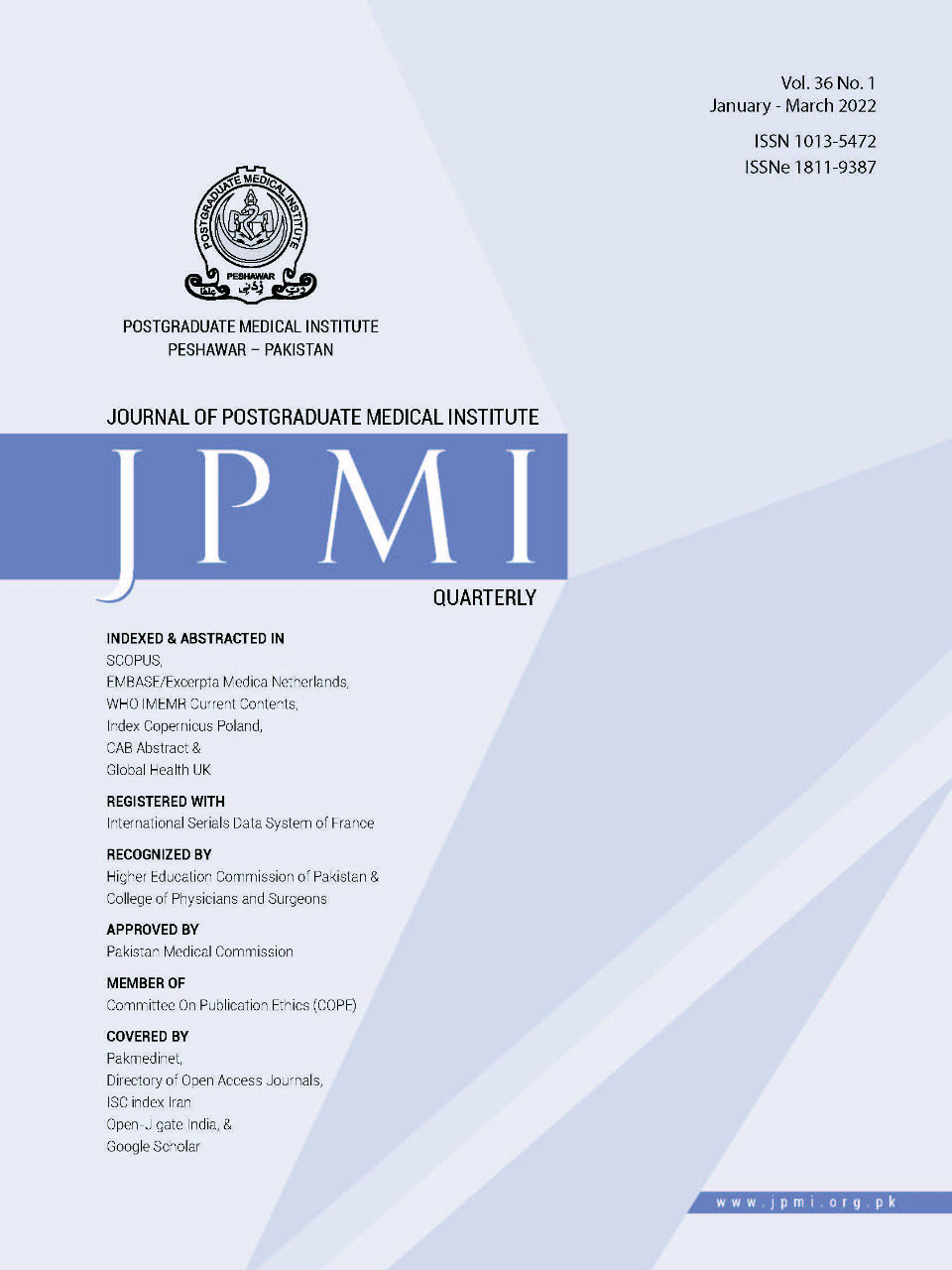OPTIMAL USE OF COMPUTED TOMOGRAPHY KIDNEY, URETER, AND BLADDER: REVIEW OF PATIENTS PRESENTING WITH ACUTE FLANK PAIN
Main Article Content
Abstract
Objective: To describe detection and management of alternative pathology established by Computed Tomography (CT) Kidney, Ureter, and Bladder (KUB) in patients associated with acute flank pain.
Method: This retrospective review of 300 patients, presented with acute flank pain during one year from March 2019 to March 2020. All Computerized Tomographies were ordered from the Emergency Room after consultation with a urologist and subsequently reported by a consultant radiologist having a minimum of two years of experience in reporting non-contrast CT scans.
Results: A total of 300 patients presented to the emergency room with acute flank pain, out of whom 198 (66%) were male and 102 (34%) were female patients with a mean age of 35 years. The majority (n=249) of the patients were diagnosed with ureteric calculi and the remaining 51 patients (17%) came out to have alternative radiological findings. Eighteen (35.2%) patients were those who needed acute surgical management which included 13 female and 5 male patients. The remaining 33 (64.7%) patients were referred to specialized clinics as there was no emergency involved. The clinically important alternative findings were overall higher in the female cohort i.e., 25.5% versus 9.8% in male patients. Genitourinary findings were discovered in 11(21.5%) patients while 7 (13.7%) patients had non-genitourinary pathologies requiring emergency management.
Conclusion: CT-KUB is a useful tool for investigating acute flank pain aiding the decision-making process. The majority of the patients were diagnosed to have ureteric calculi with a significant number of alternative diagnoses mainly in the female population.
Article Details
Work published in JPMI is licensed under a
Creative Commons Attribution-NonCommercial 2.0 Generic License.
Authors are permitted and encouraged to post their work online (e.g., in institutional repositories or on their website) prior to and during the submission process, as it can lead to productive exchanges, as well as earlier and greater citation of published work.
References
Trinchieri A. Epidemiology of urolithiasis: an update. Clin Cases Miner Bone Metab. 2008;5(2):101–6.
Smith RC, Rosenfield AT, Choe KA, Essenmacher KR, Verga M, Glickman MG, et al. Acute flank pain: comparison of non-contrast-enhanced CT and intravenous urography. Radiology. 1995;194(3):789–94. DOI.org/10.1148/radiology.194.3.7862980
Ahmed F, Zafar AM, Khan N, Haider Z, Ather MH. A paradigm shift in imaging for renal colic-Is it time to say good bye to an old trusted friend.International Journal of Surgery. 2010;8(3):252–6.
Homer JA, Davies-Payne DL, Peddinti BS. Randomized prospective comparison of non-contrast enhanced helical computed tomography and intravenous urography in the diagnosis of acute ureteric colic. Australas Radiol. 2001;45(3):285–90. DOI.org/10.1046/j.1440-1673.2001.00922.x
Denton ER, Mackenzie A, Greenwell T, Popert R, Rankin SC. Unenhanced helical CT for renal colic--is the radiation dose justifiable? Clin Radiol. 1999;54(7):444–7. DOI.org/10.1016/s0009-9260(99)90829-2
Rekant EM, Gibert CL, Counselman FL. Emergency department time for evaluation of patients discharged with a diagnosis of renal colic: unenhanced helical computed tomography versus intravenous urography. J Emerg Med. 2001;21(4):371–4. DOI.org/10.1016/s0736-4679(01)00376-6
Khan N, Ather MH, Ahmed F, Zafar AM, Khan A. Has the significance of incidental findings on unenhanced computed tomography for urolithiasis been overestimated? A retrospective review of over 800 patients. Arab J Urol. 2012;10(2):149–54. DOI.org/10.1016/j.aju.2012.01.002
Sarofim M, Teo A, Wilson R. Management of alternative pathology detected using CT KUB in suspected ureteric colic. Int J Surg. 2016;32:179–82. DOI.org/10.1016/j.ijsu.2016.06.047
Homer JA, Davies-Payne DL, Peddinti P, Spencer B;., Dretler BA. Randomized pro-spective comparison of non-contrast enhanced helical com-puted tomography and intravenous urography in thediagnosis of acute ureteric colic. Urol ClinNorth Amer. 2000;45:231–41.
Spencer BA, Wood BJ, Dretler SP. Helical ct and ureteral colic. Urol Clin North Am. 2000;27(2):231–41.DOI.org/10.1016/s0094-0143(05)70253-6
Schulz RJ, Gignac C. Application of tissue-air ratios for patient dosage in diagnostic radiology. Radiology. 1976;120(3):687–90.DOI.org/10.1148/120.3.687
Ahmad NA, Ather MH, Rees J. Incidental diagnosis of diseases on un-enhanced helical computed tomography performed for ureteric colic. BMC Urol. 2003;3(1). DOI.org/10.1186/1471-2490-3-2
Hoppe H, Studer R, Kessler TM, Vock P, Studer UE, Thoeny HC. Alternate or additional findings to stone disease on unenhanced computerized tomography for acute flank pain can impact management. J Urol. 2006;175(5):1725–30; discussion 1730. DOI.org/10.1016/S0022-5347(05)00987-0
Nadeem M, Ather MH, Jamshaid A, Zaigham S, Mirza R, Salam B. Rationale use of unenhanced multi-detector CT (CT KUB) in evaluation of suspected renal colic. Int J Surg. 2012;10(10):634–7.DOI.org/10.1016/j.ijsu.2012.10.007
Hall TC, Stephenson JA, Rangaraj A, Mulcahy K, Rajesh A. Imaging protocol for suspected ureteric calculi in patients presenting to the emergency department. Clin Radiol. 2015;70(3):243–7.DOI.org/10.1016/j.crad.2014.10.013
Patatas K. Does the protocol for suspected renal colic lead to unnecessary radiation exposure of young female patients. Emerg Med J. 2010;27(5):389–90. DOI.org/10.1136/emj.2009.084780


